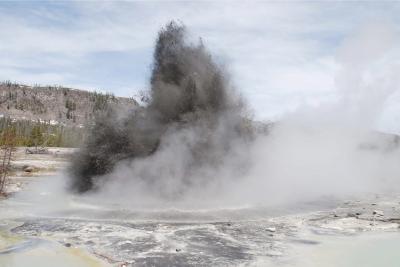Editor's note: In its latest column, Yellowstone Caldera Chronicles looks at the hydrothermal explosion at White Island in New Zealand and what lessons it offers for Yellowstone National Park. Shaul Hurwitz, research hydrologist with the U.S. Geological Survey, wrote the column.
On December 9, 2019, a fatal hydrothermal explosion (also called a phreatic eruption) occurred at White Island (Whakaari), a volcanic island 30 miles (48 km) from the north-northeast coast of New Zealand's North Island. The explosion spewed rocks and toxic gases and launched an ash plume that surged outwards and rose to about 4 kilometers (about 12,000 ft) into the air. There were 47 people on the island at the time of the explosion, and 20 of them were killed, with the rest suffering severe injuries. This was unfortunately not the first tragic event on White Island. Sulfur mining took place in the crater between the 1880s and the 1930s, and eleven miners were killed by a debris avalanche in 1914, when part of the volcano's crater rim collapsed unrelated to any eruption.

Whakaari volcano on White Island, New Zealand. View into the crater with extensive hydrothermal alteration visible in the yellow, orange and red coloring of crater wall rock.
Whakaari/White Island is the tip of a submarine stratovolcano at the northern end of the Taupo Volcanic Zone and has been active for at least 150,000 years. For the past 40 years it has been New Zealand's most active volcano. White Island is monitored by GeoNet—the agency that operates New Zealand's geological hazard monitoring systems. Like the USGS volcano observatories, GeoNet provides eruption updates, volcanic alert level summaries, and monitoring information. Volcano monitoring agencies relay scientific information to government agencies and land managers so that they can make informed decisions regarding closures at active volcanoes.
White Island has erupted many times in recent history, with very frequent eruptions from 1976-2000. A major eruption formed a new crater in 2000, and small eruptions occurred in 2012, 2013, and 2016. The volcano had been showing signs of unrest for several weeks before the December 9, 2019, explosion. In October, seismic tremors and sulfur dioxide (SO2) gas emission rates were at their highest levels since 2016, indicating an increased likelihood of an eruption. On November 18, GeoNet raised the Volcanic Alert Level to 2, indicating "moderate to heightened volcanic unrest".
White Island is privately owned, and private tour operators set policies on whether to visit the island. Although the elevated GeoNet alert level indicated there was a heightened potential for eruption hazards, the island remained open for visitation.

Hydrothermal explosion at Biscuit Basin in Yellowstone National Park. These types of events are the most likely explosive hazard from the Yellowstone Volcano.
This is sadly not the only example of a recent fatal hydrothermal blast. In 2014, over 60 hikers were killed when Japan's Mount Ontake experienced a small hydrothermal explosion. These hazardous events are challenging to forecast because they occur due to subtle changes in a volcano's hydrothermal system. The processes preceding the explosions are typically localized in areas that are much smaller than the spacing between monitoring instruments.
What do these hydrothermal explosions have to do with Yellowstone? Hydrothermal explosions are the most likely of Yellowstone's various volcanic hazards, and the potential for additional future explosions is not insignificant. Hydrothermal explosions in Yellowstone that form craters greater than 100 meters (328 ft) wide occur on average every 700 years. The largest hydrothermal explosions in Yellowstone occurred after an icecap more than 1 km (0.6 miles) thick receded from the Yellowstone Plateau about 13,000 years ago. Smaller explosions in Yellowstone, forming craters one to a few meters across, occur on average every two years. Some recent examples include the explosions of Excelsior Geyser in Midway Geyser Basin in the 1880s, the 1989 explosion of Porkchop geyser in Norris Geyser Basin, the 2009 explosion of Wall Pool at Biscuit Basin, and the small explosion at Ear Spring in the Upper Geyser Basin in 2018. None of these explosions harmed people; the Biscuit Basin explosion was actually witnessed by a group of geologists!
Monitoring data and observations generally show when an area has a higher potential for hydrothermal explosions. Sometimes, the signs can last for weeks, as at White Island, but sometimes they happen too close in time to the explosion to be taken for warnings. At Ontake, signals preceding the 2014 explosion lasted only minutes and were only recognized in retrospect.

Excelsior Geyser erupted in a series of violent hydrothermal explosions in the 1880s and early 1890s; one of these eruptions is shown in this colorized postcard made from a photograph. These were the largest such events to occur in the Yellowstone region in historical times/(Original photograph by F. Jay Haynes, 1888; date on postcard is incorrect.)
The land manager in Yellowstone is the National Park Service (NPS), which is one of the consortium members of YVO. NPS is responsible for enforcing rules to ensure visitor safety. They use monitoring data and interpretations by USGS and other Yellowstone Volcano Observatory scientists to identify changes in hydrothermal activity that could pose hazards to anyone nearby. This information prompted the NPS to close parts of Norris Geyser Basin in July 2003 and parts of the Upper Geyser Basin in September 2018 in response to changes in hydrothermal activity.
The lethal hydrothermal explosions at White Island and Mount Ontake emphasize the importance of scientific research into the processes that precede the explosions and the signals they might generate, as well as for better monitoring of hydrothermal systems in general. These explosive events also highlight the need for good lines of communication between scientists, policy makers and land managers, and for more public awareness of these unique hazards.




 Support Essential Coverage of Essential Places
Support Essential Coverage of Essential Places







Comments
Mother Nature bats last.
The crater collapse in 1914 caused an eruption, which killed the workers.